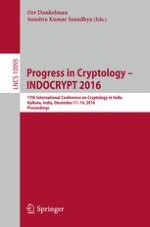2016 | OriginalPaper | Buchkapitel
Receiver Selective Opening Security from Indistinguishability Obfuscation
verfasst von : Dingding Jia, Xianhui Lu, Bao Li
Erschienen in: Progress in Cryptology – INDOCRYPT 2016
Aktivieren Sie unsere intelligente Suche, um passende Fachinhalte oder Patente zu finden.
Wählen Sie Textabschnitte aus um mit Künstlicher Intelligenz passenden Patente zu finden. powered by
Markieren Sie Textabschnitte, um KI-gestützt weitere passende Inhalte zu finden. powered by
